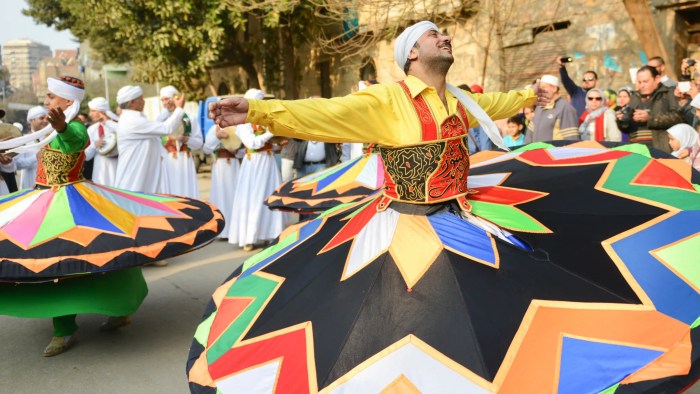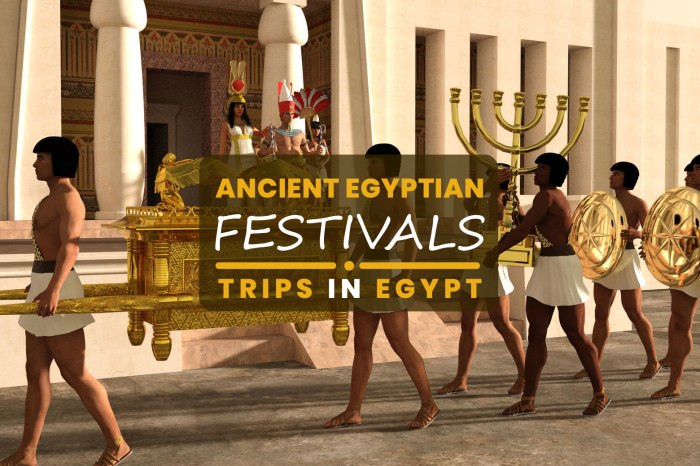Egyptian Festival: Step into a world of vibrant celebrations, ancient rituals, and captivating history. From the grand festivals honoring powerful gods to the intimate ceremonies marking life’s milestones, ancient Egypt’s rich tapestry of festivities offers a glimpse into a civilization that continues to fascinate us. This exploration delves into the origins, evolution, and enduring legacy of these remarkable events, revealing the profound connection between faith, culture, and the rhythm of life in ancient Egypt.
We’ll journey through millennia, examining the diverse types of festivals – agricultural, religious, funerary – and the unique practices associated with each. We’ll uncover the symbolism embedded within iconic motifs, colors, and objects, deciphering the messages conveyed through music, dance, and culinary traditions. Finally, we’ll explore how these ancient celebrations resonate in modern Egypt, demonstrating the enduring power of heritage and the continuous adaptation of cultural traditions.
History of Egyptian Festivals

Ancient Egyptian festivals, deeply interwoven with their complex religious beliefs and agricultural cycles, offer a fascinating glimpse into the lives and worldview of one of history’s most enduring civilizations. These celebrations weren’t merely occasions for merriment; they were vital rituals designed to ensure the continued prosperity of the pharaoh, the nation, and the cosmos itself. Their evolution across millennia reflects the changing political landscape, religious doctrines, and societal structures of ancient Egypt.
Origins and Evolution of Significant Festivals
The earliest Egyptian festivals, dating back to the Predynastic Period (before 3100 BCE), were likely linked to the natural world and agricultural practices. As the civilization developed and a complex pantheon of gods emerged, festivals became increasingly elaborate, reflecting the growing importance of religious rituals in maintaining Ma’at, the cosmic order. The Old Kingdom (c. 2686-2181 BCE) saw the establishment of many key festivals associated with the pharaoh’s divine role, while the Middle Kingdom (c.
2055-1650 BCE) and New Kingdom (c. 1550-1069 BCE) witnessed the rise of festivals dedicated to specific deities and regional cults. The later periods, including the Late Period and Ptolemaic era, saw a blending of indigenous traditions with those of the Greeks and Romans, resulting in syncretic festivals that incorporated elements from multiple cultures.
Types of Egyptian Festivals
Ancient Egyptian festivals weren’t just celebrations; they were deeply interwoven with the fabric of their society, reflecting their agricultural cycles, religious beliefs, and even their understanding of the afterlife. Understanding these festivals offers a profound glimpse into the complexities of their civilization. They weren’t merely occasions for merrymaking, but vital rituals that reinforced social order, ensured agricultural prosperity, and appeased the gods.
Egyptian festivals fell into several broad categories, each with its unique characteristics and purposes. These categories weren’t always strictly defined, with many festivals blending elements from multiple types. However, examining them through this lens provides a clear understanding of their significance within ancient Egyptian life.
Agricultural Festivals
Agricultural festivals were intrinsically linked to the Nile’s annual flooding, the lifeblood of Egyptian civilization. The success of the harvest directly impacted the entire society, making these festivals crucial for ensuring prosperity and expressing gratitude to the gods who controlled the life-giving waters. These celebrations often involved elaborate rituals aimed at ensuring a bountiful harvest in the coming year.
The timing of these festivals was dictated by the agricultural calendar, ensuring they coincided with crucial stages of planting and harvesting.
Religious Festivals
Religious festivals formed the largest category, dedicated to honoring the vast pantheon of Egyptian gods and goddesses. These festivals were often elaborate affairs, involving processions, sacrifices, dramatic performances, and public displays of devotion. Their purpose extended beyond simple worship; they served to reinforce religious beliefs, strengthen community bonds, and maintain the cosmic order as perceived by the Egyptians.
The scale and frequency of these festivals varied significantly depending on the importance of the deity being celebrated.
Funerary Festivals
Funerary festivals, while somber in nature, were equally important. They focused on ensuring the successful transition of the deceased into the afterlife and providing continued support for the departed. These festivals involved elaborate rituals, offerings, and ceremonies designed to guide the deceased through the perils of the underworld and secure their eternal well-being. The scale of these events often reflected the social status of the deceased, with pharaohs receiving the most elaborate funerary rites.
| Festival Name | Category | Purpose | Key Rituals |
|---|---|---|---|
| Opet Festival | Religious | Celebrate the fertility of the land and the union of Amun, Mut, and Khonsu. | Processions, offerings, and symbolic re-enactments of the gods’ journey. |
| Sed Festival | Religious, Royal | Renew the pharaoh’s power and legitimacy. | Symbolic runs, ritual combats, and offerings to the gods. |
| Feast of Thoth | Religious | Honor the god of writing, wisdom, and the moon. | Rituals involving writing, astronomical observations, and offerings. |
| Shemu Festival (Harvest Festival) | Agricultural | Celebrate the successful harvest and give thanks for the Nile’s bounty. | Celebrations, feasting, offerings to the gods, and agricultural rituals. |
Modern Celebrations of Egyptian Heritage

Ancient Egyptian festivals, though centuries past, continue to resonate deeply within modern Egyptian culture. Their echoes reverberate in contemporary celebrations, subtly shaping traditions and providing a powerful link to a rich and storied past. While the specifics of ritual and practice have evolved, the underlying themes of community, celebration, and connection to the divine persist, reinterpreted for a modern audience.
This enduring legacy is a testament to the enduring power of cultural heritage.The modern celebration of Egyptian heritage draws heavily on the symbolic imagery and themes of ancient festivals. Many contemporary events incorporate elements designed to evoke a sense of the past, offering a blend of historical appreciation and modern entertainment. This dynamic interplay between ancient traditions and modern interpretations offers a unique cultural experience.
Contemporary Events Inspired by Ancient Traditions
Contemporary Egypt witnesses numerous events that subtly, or sometimes overtly, draw inspiration from ancient festivals. The celebration of Sham el-Nessim, for example, though its precise origins are debated, is often linked to ancient Egyptian spring festivals celebrating the renewal of life. Modern celebrations involve family picnics in parks, enjoying traditional foods, and generally embracing the arrival of spring.
This contrasts with the ancient celebrations, which likely involved more elaborate religious rituals and processions, but the fundamental theme of springtime renewal remains a common thread. Similarly, the many religious holidays observed in Egypt, such as Eid al-Fitr and Eid al-Adha, while rooted in Islamic tradition, often incorporate elements of community gathering and feasting that mirror the social aspects of ancient Egyptian celebrations.
These modern celebrations retain the communal spirit and joyful atmosphere characteristic of ancient festivals, albeit with modified rituals and practices.
A Modern Egyptian Festival: The Nile’s Embrace
Imagine a vibrant festival, “The Nile’s Embrace,” held annually along the banks of the Nile River. Inspired by ancient festivals honoring the life-giving river, it features a grand procession of illuminated boats adorned with papyrus and lotus flower motifs, reminiscent of ancient ceremonial barges. Modern music and dance performances, incorporating traditional Egyptian rhythms and steps, blend with light shows projecting images of ancient gods and pharaohs onto the river’s surface.
Food stalls offer traditional Egyptian delicacies, creating a bustling marketplace atmosphere. The festival culminates in a spectacular fireworks display, symbolizing the Nile’s enduring power and its vital role in Egyptian life, echoing the ancient reverence for the river god Hapi. This contemporary festival seamlessly weaves ancient symbolism with modern entertainment, creating a captivating experience that celebrates both the past and the present.
Symbolism and Iconography in Egyptian Festivals
Egyptian festivals, vibrant expressions of religious belief and cultural identity, are rich in symbolism and iconography. These visual elements weren’t merely decorative; they served as powerful communicators of complex theological concepts, social structures, and historical narratives, deeply embedding themselves within the fabric of Egyptian society. Understanding this symbolism provides a crucial key to unlocking a deeper appreciation of the festivals themselves and the civilization that created them.The pervasive use of specific motifs, colors, and objects within these celebrations wasn’t arbitrary.
Each element held a specific meaning, often layered with multiple interpretations depending on the context of the festival. This intricate system of visual communication ensured that even those who couldn’t read hieroglyphs could participate in and understand the deeper significance of the events.
The Significance of Color in Egyptian Festivals
Color played a vital role in conveying meaning within Egyptian festivals. For example, gold, associated with the sun god Ra and immortality, frequently adorned statues of deities and royal figures participating in processions. Its brilliance symbolized divine power and the eternal cycle of life and death. In contrast, blue, representing the sky and the Nile’s life-giving waters, often appeared in depictions of gods associated with fertility and abundance, emphasizing their connection to the land’s prosperity.
The use of these colors, and others like red (representing life and chaos) and green (symbolizing rebirth and vegetation), was carefully orchestrated to reinforce the thematic messages of each festival.
Symbolic Objects in Egyptian Festivals
Many objects held profound symbolic significance. The ankh, for instance, a symbol resembling a cross with a loop at the top, frequently appeared in festival decorations and iconography. This iconic object represented life, immortality, and the power of the gods. Its presence in a festival setting reinforced the celebration’s themes of renewal, rebirth, or the veneration of a deity associated with life-giving forces.
Similarly, the djed pillar, a stylized representation of the backbone, symbolized stability, strength, and the enduring power of the pharaoh and the divine order. Its inclusion in festival imagery emphasized the importance of maintaining cosmic balance and the Pharaoh’s role in upholding it.
The Role of Animal Representations in Festival Iconography, Egyptian Festival
Animals occupied a prominent place in Egyptian religious beliefs and, consequently, in festival iconography. The scarab beetle, for example, symbolized rebirth and regeneration due to its life cycle. Its depiction in festival scenes often linked the celebration to themes of renewal and the cyclical nature of time. Similarly, the falcon, associated with the god Horus, represented royalty, protection, and divine power.
Its presence in festival art underscored the connection between the pharaoh and the divine realm. The choice of animal symbols was carefully considered, aligning with the specific deity or theme being celebrated.
The Eye of Horus: A Visual Description
The Eye of Horus, a powerful symbol frequently featured in Egyptian festivals, is depicted as a stylized human eye, often with distinctive markings. Its appearance varies, but it generally includes a tear-like shape emanating from the lower eyelid. The Eye of Horus is not just a simple image; it represents protection, healing, and royal power. Its presence in festival settings invoked the god Horus’s protective presence and signified the festival’s association with healing, prosperity, or the reinforcement of the pharaoh’s authority.
The intricate details of its design, including the specific markings and the variations in its depiction across different festivals, further emphasized its multi-faceted symbolic meaning.
The Egyptian Festival, in its ancient and modern forms, stands as a testament to the enduring power of cultural heritage. From the elaborate rituals honoring gods to the contemporary celebrations that echo ancient traditions, these festivals offer a window into the soul of a civilization. By understanding the history, symbolism, and artistic expressions woven into these events, we gain a deeper appreciation for the complexities and richness of ancient Egyptian life and its lasting impact on the world.
The echoes of these vibrant celebrations continue to resonate, reminding us of the enduring human need for connection, community, and the celebration of life itself.